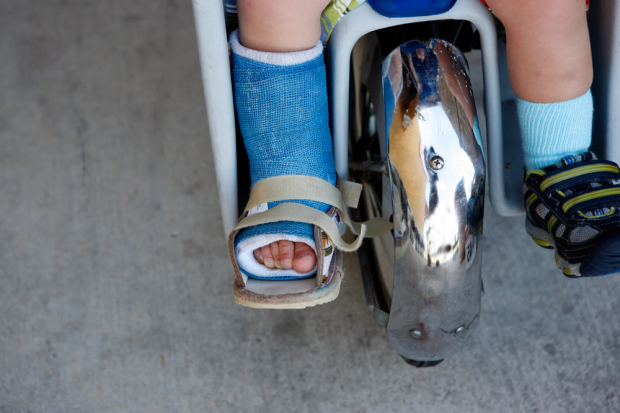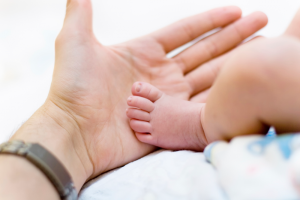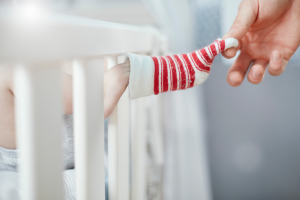Corrective Brace Wear Tips To Help Kids Adjust To Ankle And Leg Braces
Having to wear a foot or leg brace is no fun for babies and small children, so follow these tips and tricks to help your child adjust quickly to his or her corrective brace wear.
Having a potentially uncomfortable or painful foot condition is hard enough for a baby or toddler to endure, and being required to wear a foot brace, ankle brace or leg brace makes things like clubfoot, foot drop, infant hip dysplasia and pigeon foot all the more miserable. Many babies and toddlers are resistant to wearing corrective foot and leg devices, leading to fussiness, crying and temper tantrums. All kids will most likely need at least a few days to get used to their new “restraints”, but there are several ways to make the brace adjustment period much quicker as well as to ensure continued success with foot, ankle and leg brace wear.
The Easiest Ways To Help Your Baby Or Toddler Adjust To Corrective Brace Wear
Set a Routine for Wearing the Brace: Children often function better with set routines, and this goes for wearing foot and leg braces as well. When your child is required to wear the brace for a certain amount of hours in the day, stick to the same schedule so he or she knows what to expect. For example, if your child is supposed to wear an ankle brace or leg brace during naptime and in the night, be sure to always put the brace on just as he or she is getting into their sleeping spot. Consistency is key in avoiding potential tantrums and resistance.
Have Brace Playtime: One of the quickest ways to help a baby or child adjust to a foot or leg brace is by having him or her immediately engage in regular activities, especially playtime activities, while wearing the brace. If your child is resistant (usually due to being constrained in a cast for several weeks or months), you can gently bend and straighten his or her knees by gently pushing and pulling on the brace. Kids who must wear a solid clubfoot bar (often called Denis Browne bars or Ponseti AFOs) that is attached to both feet can kick and move their legs simultaneously.
Make the Brace Comfortable: Braces are solid by nature, so help prevent further discomfort by padding the bar or any other solid surfaces. You can use car seat strap covers or bicycle handle bar padding to achieve this. Padding helps protect your child as well as furniture and other items from being damaged by the brace’s metal bar.
Tips For Continued Ankle Brace and Leg Brace Success
Prevent Escapes: It is extremely important that corrective braces be worn for the recommended time periods, which are usually 23 hours a day for infants and 12 to 14 hours per day for toddlers. Lack of consistency can lead to reoccurrence in your baby or toddler's deformity as well as longer healing times. Therefore, it’s important to make sure that your child doesn’t escape from his or her foot, ankle or leg brace. You can help keep your child in his or her brace by:
- Tightening the brace by one more hole, starting with the middle strap
- Trying thinner or thicker socks with non-slip soles
- Try having your child wear two pairs of socks, one over the foot and one over the removable sole insert of the brace
- Try having your child wear no socks
- Try removing the tongue of the shoes attached to the brace
- Try reverse lacing your child's shoes so that the bow is closer to the toes
- Use larger shoe lacing to prevent the laces from becoming loose
- Always make sure your baby or toddler's heel fully settles down into his or her shoe
- Do not use any lotions, creams or powders on the foot as they allow the foot to slide (which can also cause blisters)
If all of the above fail, you may want to try contacting your child’s doctor or orthopedic surgeon for advice as well as whether or not he or she will suggest a different brace.
Check For Brace Irritation: Foot and leg braces can create skin irritation on babies and toddlers, especially during the first couple weeks of wear. It’s important for parents to check their child’s feet several times per day for red spots, blisters or other signs of skin irritation. Any noticeable skin changes should be discussed with his or her doctor. It’s also important for parents to continually check and make sure all of his or her child’s toes are showing.
*Additional tip: Try and do these daily checks during periods when your child is relaxed and happy. Doing so will decrease the chance that your child begins connecting crying with brace removal.
Bring the Brace to Checkups: Once your child is fitted with his or her brace, it’s important to bring it to every bracing appointment. This will ensure that the doctor or orthopedic surgeon can assess the effectiveness of the device as well as look for any potential fitting problems.
Notice concerning medical entries:
Articles having medical content shall serve exclusively for the purpose of general information. Such articles are not suitable for any (self-) diagnosis and treatment of individual illnesses and medical indications. In particular, they cannot substitute for the examination, advice, or treatment by a licensed physician or pharmacist. No replies to any individual questions shall be effected through the articles.







